If you use beauty products, it’s impossible to not have heard of clean beauty. It’s a revolution. You want your products to be clean – you don’t want to use dirty products! You want your products to be good for your health and good for the environment. There are beautiful celebrities telling you about how they detoxed and cleaned out their beauty routine, and how much better they feel.
But what if all of this was based on a lie?
Let’s talk about the science – or the lack of science – behind clean beauty.
Here’s the video version on YouTube, keep scrolling for the written version…
What Is Clean Beauty?
Clean beauty is one of those concepts that everyone seems to understand, but no one can really agree on an exact definition (like “good music”).
Generally the idea is:
- You download a list of dirty or nasty ingredients from somewhere, and these are supposedly not good for your health or not good for the environment.
- You check your product’s ingredients against this list.
- If it has any of these ingredients it’s dirty, if it doesn’t then it’s clean.
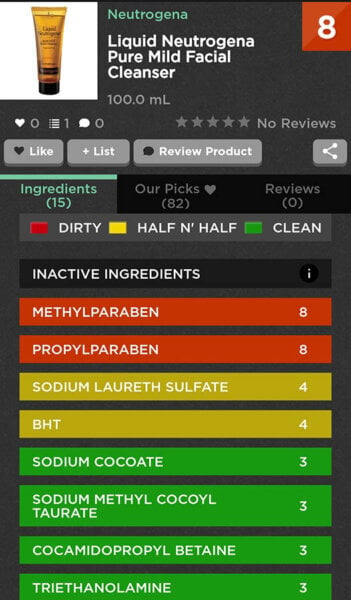
It’s a pretty straightforward concept – enticingly simple – and like a lot of other enticingly simple concepts, it doesn’t actually work (if it did, I wouldn’t be writing this post).
Firstly, just to clarify:
- I care about my health. I exercise regularly, I eat a balanced diet, I want to use safe and effective products, and I’m not willing to trade my health for nicer skin.
- I also love the environment. I grew up in a semi-rural part of Australia, I love bush walks, I try to recycle, I try to reduce my carbon footprint. I take public transport, I vote for politicians who want to do something about climate change, I donate every year to environmental causes.
What I’m against is:
- Feel-good actions that don’t actually make us more healthy or potentially make us less healthy
- Feel good actions that don’t actually help the environment or even make it worse
- Corporations taking advantage of consumers’ good intentions by marketing their products based on feel-good actions and myths, so you end up buying products that don’t actually do what they promise (and it comes with a big dose of fear-mongering and guilt-tripping on the side)
- People who should really know better, whether they’re scientists or companies that can afford to hire scientific advisors, spreading myths about what does and doesn’t hurt your health and the environment
If you’ve spread any of these myths in the past, don’t feel too bad. We’re all human! I’ve done it before. We just have to be open to new information, try to assess it critically, and do better in the future.
And before anyone calls me a shill, this post isn’t sponsored. There are a lot of companies in my inbox who want to pay me to talk about how clean their products are, but I can’t because that’s completely against how science and reality work.
With all of that out of the way, let’s talk about why clean beauty is BS.
(I’m going to be focusing on the health side of clean beauty because that’s what most brands focus on, and this post is long enough already. There are massive issues with the environmental side of clean beauty as well – I might talk about that in the future.)
Hazard vs Risk
First off, ingredients aren’t clean or dirty.
Clean beauty divides ingredients into clean and dirty, or nice and nasty, or yay and icky, or non-suspicious and suspicious, or non-toxic and toxic, or whatever version the brand’s marketing team wants them to use.
But you can’t say that an ingredient is good or bad without considering how it’s used. Drinking a glass of water is very different from inhaling a glass of water. And the amount of ingredient that you use makes a huge difference as well: inhaling some steam is very different from inhaling a whole river.

In toxicology (the science of how good and bad substances are for you), there’s the concept of a hazard and a risk.
- A hazard is a potential source of harm
- A risk is how likely that harm will actually happen in a given situation
I asked Dr Fred Lebreux to explain these concepts – he’s a chemist with a PhD in medicinal chemistry, and a toxicologist with more than 10 years of experience in evaluating cosmetic products. He’s the CEO of Biorius, a company that specialises in safety assessments and regulatory compliance for cosmetic products.
Fred: “The risk is a product between exposure and hazard, which means that if there is no exposure, even if the hazard is very high, the risk is very low. And when you come to cosmetic products, it just means that a substance by itself is not good or bad – it is more how you are exposed to this substance that is so critical.
To explain I will use a very simple example: the example of a lion.
So the lion is intrinsically dangerous. It has the potential to be very hazardous. But it doesn’t mean automatically that it is risky.
If you go to the zoo and you are behind the bars, there is absolutely no risk. The lion is dangerous of course – it remains dangerous – but there is no risk because there is no exposure to this lion.
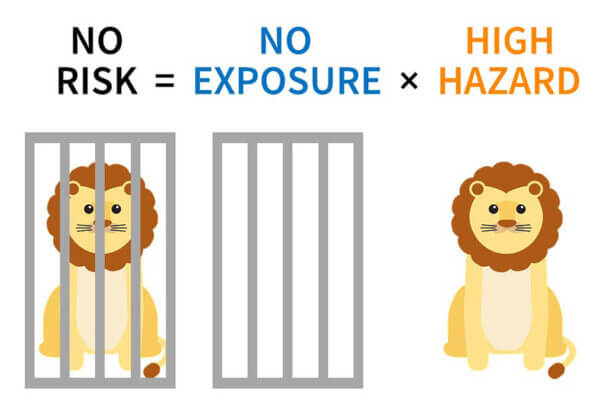
If you are in Africa, in a safari, and you are in front of a lion and there are no bars between this lion and yourself, the risk is very high because the hazard is the same, but the exposure is not the same anymore. The exposure is much higher.”
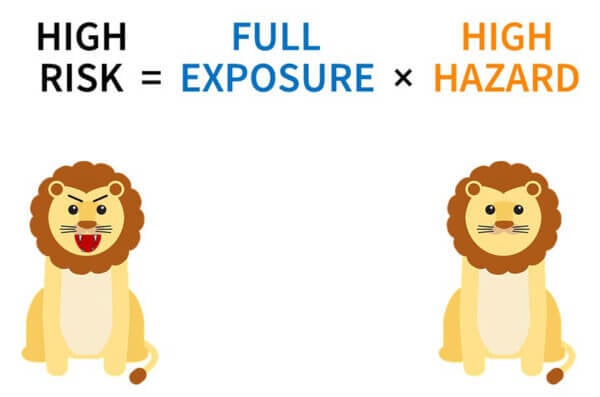
So the fundamental problem with clean beauty is that it makes you rule out ingredients and products based on the hazards – the potential dangers – without considering your exposure, to work out the overall risk of the situation you’re up against. It’s like never drinking water because you’re scared of drowning.
That’s why every brand has a different nasty list – because this approach makes no sense. If you only look at hazards, then every single ingredient can be considered hazardous.
Sometimes clean beauty lists have a token disclaimer saying you have to also consider where and how you use a product, and how much you’re using, so it’s not like they haven’t heard of the idea of risk. But then they go on to completely ignore this by telling you it’s black or white, clean or dirty: if it’s on the list it’s out, regardless of how much exposure you get.
How Scientists Actually Work Out Risk
So how do real toxicologists work out how much of an ingredient is safe to use in cosmetics?
Fred: “Once we have qualified this danger, we have to assess the exposure. What’s the quantity of a given ingredient? What’s the quantity that will end up on the face of a consumer? And it’s not that easy to calculate – it’s a lot of equations, it’s a lot of calculations, but we have to do it. And many parameters are taken into consideration.
So: how many times a consumer is going to use the product on average? What quantity is going to be used? Is it a pea-sized amount, is it more, is it less? Is it a rinse-off product? Is it a leave-on product? So all of that is going to have a great impact.
And once we have a clear exposure scenario, and a very good idea of how much of an ingredient is going to end up on the face of a consumer, we can really compare the hazard and the exposure. As you know the risk is an equation: it’s the product of hazard and exposure.”
This is how the usage limits are set – how much of an ingredient that formulators are meant to use in a product. These limits are based on how much of a product you use, how many times you’ll use it in a day, whether it’s rinse off or leave on, and it’s added up across all the different products that you might reasonably use.
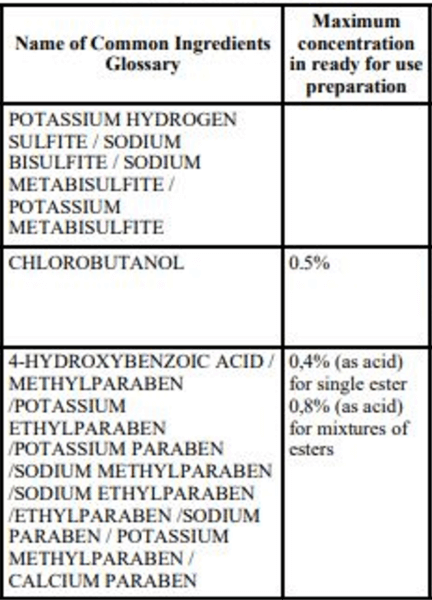
Parabens: personally victimised by clean beauty
Let’s look at one example: parabens. These are really useful preservatives that are found on lots of dirty lists. According to these lists, parabens are linked to hormonal or endocrine disruption, they can increase the risk of breast cancer, and they can be irritating to skin.
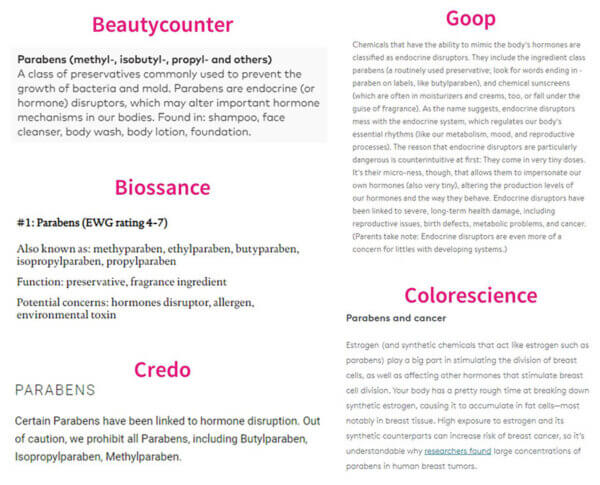
All of this is technically true and it sounds really scary – no one wants cancer or endocrine problems! But if you look closely at the actual evidence, and if you have some idea of how to interpret it, you’ll start to see problems.
(Side note: most of these “dirty” lists were not put together by scientists, and certainly not toxicologists. More often than not, they don’t cite any studies to back up what they’re saying.)
Related post: Should You Be Avoiding Parabens? The Science
Not all parabens are the same
First off, there are lots of different parabens, and these all have different hazards and risks. But most clean beauty lists just lump them all together. Some of them talk about them separately… and then lump them together anyway.
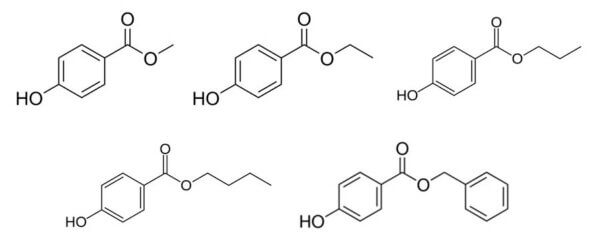
Studies aren’t interpreted with nuance
When they actually list the studies, a lot of them are done in vitro on cells, or on animals. Cells and animals behave very differently from living human skin – cells can die with tap water, and dogs can die from chocolate. Animal studies also usually involve really unrealistic situations that have limited relevance to how we use parabens in everyday life – for example, a lot of these involved having rats that ate large amounts of parabens.
Human studies also haven’t found a really clear link to health effects, even though parabens have been used for about a hundred years. Parabens are mildly estrogenic, but compared to a lot of the other estrogens we encounter in everyday life like by eating tofu they are really mild.
Natural bias
You can also see a pattern in how these companies treat natural and synthetic chemicals. Natural chemicals aren’t held up to the same level of scrutiny as synthetic chemicals, even though there are lots of natural ingredients that aren’t good for you. This is the appeal to nature bias which I’ve talked about before.
Related post: Are Natural Beauty Products Better?
More knowledgeable people have already interpreted these studies
On top of this, toxicologists have analysed all of these studies before and published their conclusions – this is how the safe limits of ingredients and cosmetics are set (as part of the hazard assessment part of the safety assessment). They regularly re-review new studies. It’s not like these clean beauty organisations are digging up damning new evidence that no one’s ever thought to look at before.
I’m not saying that we won’t someday find out that parabens or some other “toxic” ingredients are actually bad for our health. New science can come out that changes our perspectives. My point is that on one side, we have scientists with years and years of specialised knowledge and experience in this specific area saying that these levels are safe – and on the other side, we have people who don’t know the very basics of toxicology with a very obvious financial interest saying that we need to avoid them entirely.
Why take any risk at all?
But why take any risk at all? Why not take out any ingredients that could potentially be hazardous?
Firstly, the risk is usually so small that there’s very little difference.
Fred: “…and the goal is not to take any risk. So basically we are going to take the danger, we are going to divide it by the exposure, and we obtain what we call a margin of safety. And this margin of safety is at least 100.
So the idea is we have to be absolutely sure that the exposure to the consumer is much, much lower than the quantity that may lead to an expression of a danger for the consumer.
That’s a very quick summary of what we do on a daily basis: we evaluate the danger, toxicological endpoint by toxicological endpoint, ingredient per ingredient, then we evaluate the exposure of a given cosmetic product and we are going via a complicated equations to mix the hazard and and the exposure to quantify the risk. And this risk cannot be significant. So this is why we talk about a margin of safety, to be sure that the risk that is taken by the consumer is very insignificant.”
So it’s not like the amount of parabens or other ingredients that we use in cosmetics are just below the level where we see an effect or even half that – it’s under 100 times less than that. It’s already a pretty darn precautionary approach.
And it’s important to remember that nothing in life is risk-free – a lot of the time that ingredient has an important function in the product, so getting rid of it or using alternative ingredients isn’t necessarily a less risky choice.
Option 1: Using no preservatives
Preservatives are in products for a very good reason: every time you open a product it comes into contact with air, which has microbes like bacteria, yeast and mold. These can get into the product and start growing, and can reach dangerous levels even if the product still smells and looks OK.
If you then put the contaminated product on your skin, it can cause infections, and if it gets near your eyes you can go blind. A lot of these microbes also produce allergens and irritants that can cause skin reactions. So these are very real health problems that have actually happened, compared to the largely theoretical risks with preservatives.
Preservatives have been a bit of a victim of their own success, just like with vaccines. We don’t usually think of these risks when we use cosmetic products. Preservatives work so well that these problems are quite rare, and we take them for granted.
Unless your product was manufactured under completely sterile conditions, with completely sterile raw ingredients, and you’re only using it in a completely sterile way (like an air-free container that doesn’t suck any air back in), you’ll probably get microbial overgrowth unless you have a good preservative system. This is especially likely if you’re using natural ingredients that can feed microbes – which is often the case with clean beauty products.
Option 2: Alternative Preservatives
Swapping out parabens for other preservatives might seem like an easy solution, but there are problems here as well.
The main one is that we don’t actually know very much about the health effects of newer preservatives. Parabens have been used for about a hundred years by billions of people worldwide. That’s why there have been lots of studies on them. All of this data might seem really scary, but it’s actually partly because we’ve been testing them. That means we also have a pretty good idea of their health effects, which have been minimal.
On the other hand, newer preservatives haven’t been used for as long, and they haven’t been through as much testing, so their health effects are largely unknown – especially their longer term health effects. They could be much worse.
Alternative preservatives also tend to be more problematic shor-term, mostly because they’re not as effective as parabens. One of the main reasons parabens are so popular is that they work really well at very low concentrations.
With the less effective preservatives, especially the ones that natural brands tend to use, you can either end up with a product that’s really easy to contaminate (leading to all of those issues discussed before), or a product that has a lot more preservative.
Preservatives are often quite irritating and allergenic, and so having a higher concentration means that people who wouldn’t have had skin reactions with the lower amounts of parabens might react to these newer preservatives. If you look at the data on preservatives, you’ll see how good parabens are (except, of course, to people who are specifically allergic to parabens).
These are the incidences of allergy from patch test studies in the us and europe the actual incidence of allergy in the general population will be lower
There’s also been more recalls of contaminated products recently, and a lot of this is probably linked to the fact that more and more brands are avoiding parabens because of the clean beauty movement.
So avoiding parabens and switching to products that don’t contain preservatives or contain less effective preservatives is a feel-good action that doesn’t actually make us healthier and can in fact make us less healthy.
The bottom line
In summary, clean beauty and this idea that you can divide ingredients into good and bad is fundamentally flawed from a scientific perspective: it ignores the very basics of toxicology.
Clean beauty is turning a massive profit, even though it’s not making us healthier and it could potentially be making us less healthy.
How did we get here, and how do we get out?
I do think that it’s important to recognise that the beauty industry hasn’t been very transparent in the past, and this might be why we’re so willing to buy into this incorrect science. The beauty industry hasn’t really put in much effort to communicate the actual science behind beauty products.
That’s part of the reason I started my blog back in 2011 – I wanted to know answers, I wasn’t satisfied with the answers I was getting, and getting to answers that made sense was incredibly hard. I don’t know if it’s because companies thought that consumers weren’t interested in the real science, or they didn’t think they could break down these complex concepts into something that consumers could understand.
Pseudoscience is generally easier to understand and easier to sell, but it’s not the truth. I find it really disappointing when companies that have scientists on their staff who know better decide to cave into pressure and take the easy route. That was another reason i started my blog, and why I kept going even though I was losing money for the first 6 years – I wanted to give the science a fighting chance.
I think beauty marketing has been gradually changing. I work with brands from time to time on sponsored content, and over the years I’ve seen a big shift from where they wanted me to cut down on the technical details and just post pretty pictures to now, where they tend to tell me to just go as deep into the science as I want.
And I think the fact that my numbers on Instagram, YouTube and this blog continue to grow shows that it’s possible to successfully explain the science accurately, and that people are interested in knowing the whole messy truth. So hopefully that acts as a proof of concept to brands that they can, and should, present the real story instead of giving in to pseudoscience.
Are you also sick of clean beauty? Do you think it’s ever going to go away, or is it a movement that’s just too big to be stopped? Do you think that companies investing in educating their customers is the way to go? (I’m a science educator, so I think that transparency and education is the answer to everything, but obviously I’m massively biased!) Let me know what you think.
(I couldn’t fit everything that Fred said in this video, but it’s all fascinating – I’ve uploaded his clips on the basics of toxicology in cosmetics and how safety assessments are done in their entirety on my second channel if you want to learn more about toxicology basics and how safety assessments are conducted.)


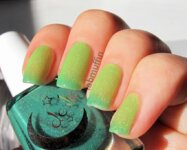
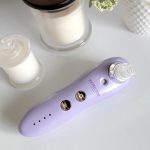
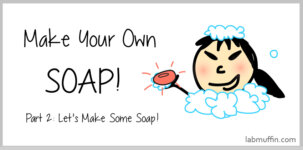

Thank you for this post! Very interesting.
One question though, is it not very hard to prove causality as far as toxicity and industrial chemicals are concerned? After moving to the US, where the chemical industry is very powerful, I have learnt that thousands of chemicals which are very damaging to our health are still in use here. The Obama administration tried to put some meaningful regulation in place but Trump of course put an end to it.
I have read that in the case of endocrine disruptors it is very hard to get sufficient data and so we keep using them because we cannot show that they are dangerous (yet). There are so many chemicals in use that it gets really complicated to study. One really nasty example is how the use of DEET was continued in the US for so long even after we suspected huge risk to both people and the environment (and is still used today in the Global South). I wonder if sometimes the hard demand for evidence in the natural sciences (95% confidence interval (?) and type I and type II errors) are causing us to act to slowly to pressing problems, and giving people who don’t want to us to solve those problems more time to spread denial and doubt. Climate change is surely an example of that.
I come from a family of scientists so I know that everything is made for chemicals and I’m personally not scared of for example parabens or aluminium in deodorant. I do not own any clean beauty products because I do not trust the marketing, but I’m also skeptical of the products available.
Sorry if I have got some of the jargon wrong. I’m not in STEM myself
There definitely are dodgy chemicals used in many situations, particularly in the US – if you’re worried about the lack of regulation in the US, I’d recommend looking at the EU regulations and following those. The SCCS publishes reviews of the data for many chemicals, so you can also look through their reasoning too! In cosmetics, the commonly fearmongered chemicals are used pretty much equally in the US and EU, but I can’t say the same for other industries.
Thank you for bringing this scientific perspective to this movement. I’m 66 and this new marketing term “clean beauty” honestly made me laugh. I grew up in the “hippie” era and dove into rather enthusiastically. To be honest most of those values have cradled my political and lifestyle choices for the past 40 years. Back in the ’70’s it was advisable to make your own beauty products just as you were encouraged to make your own everything – from cooking, to sewing to building. Many did learn the hard way that making your own cosmetics could be a “hazardous” riddled exercise! I had been using Borghese cleanser (with enthusiasm) for quite some time before I stumbled across some problems associated with “parabens”. I kept using it because I loved it and had found a place to buy it where it was incredibly reasonably priced! I was skeptical about all this negativity re parabens. You do bring such a refreshing cool headed approach to this marketing directed “clean beauty” movement that I hugely appreciate. Much like I do appreciate the work that Deciem has brought 🙂
Thank you, Michelle, for this very informative post. I jumped on the “green beauty” bandwagon 15 years ago when I had my children. They had eczema, allergies and a lot of sensitivities. I started to do research on skin and cleaning products and began to eliminate any products with synthetic fragrances, certain essential oils and ingredients taken from a hazardous list that I had obtained from the David Suzuki Foundation. My children’s eczema did get better. Today, I am just really confused and disappointed with all these claims of natural and green products. There is absolutely nothing natural about any product created and stuck in a plastic bottle and shipped to me from across the world to Canada. I really find your posts very helpful as I always feel better equipped to make my own decisions after reading them. Now if I can only sort out my love/hate relationship with NIOD products🥴
Thank you for your public service. I almost even avoid products now, that “boast” about their lack of parabens and other “nasties” even if just to spite them for their disappointing marketing tactics.
Great video! As an Esthetician of 16 years, I take responsibility for perpetuating the clean beauty movement early in my career. There were professional brands that would come to my beauty school and “educate” us on the dangers of Parabens. It was in 2003, before any clean beauty targeting consumers existed. I wanted effective safe products to use once I was out of school and quickly realized I should get on board with what was current. I think most esthetician’s and doctors did this. It usually comes down to a really good marketing team and brand development strategist. I was always interested in the science but didn’t think to question Doctors and educators.
As I launch my own skin care line now in the US, I’m reminded of the easy way. I can just jump on board with easy terms that consumers will recognize or try to educate them with my marketing and brand message. I will probably stay away from parabens because it has permeated the beauty culture here but I myself am not afraid of them. I educate my clients of the presence of parabens in fruits like blueberries and cherries. They are naturally occurring substances.
We should be able to rely the information that people in positions of authority give to us – that’s why I reserve most of my rage for scientists and doctors who promote pseudoscience! The majority of scientists and doctors don’t, but there’s always a few who end up swayed by the marketing, whether it’s out of laziness, ego or lack of critical thinking.
LOVE this, I’ve read a lot of your posts and this has got to be my favorite thus far. Please consider making this a series on phthalates, sulfates/silicones, dyes/fragrance, etc. I’m so impressed with your blog, thanks so much for these posts!
TY FOR THIS! It’s disheartening how many companies are perfectly happy to push this alarmist and wildly inaccurate “clean” narrative … and how many people are falling for it. One of the main reasons I’ve dumped Sephora is their ridiculous flagging of products as “sulfate free!!1” for items where that’s totally irrelevant — of COURSE this eyeshadow does not contain DETERGENT. Thanks for holding the line against reactionary fear-mongering and ignorance. (And speaking as an American, reactionary fearmongering and ignorance have been gaining ground these days. Would you maybe consider emigrating here and running the FDA?)
I think one of the issues is underfunding and lack of regulation – unfortunately what’s easy to understand ends up more popular when there’s too free of a market, and without some sort of intervention (e.g. government regulations on what you can and can’t say in advertising) pseudoscience takes over.
MIchelle, thank you for this. I occasionally feel I’m surrounded by a confederacy of dunces who talk about their ‘detox’, juices, superfoods and bad-for-you parabens and synthetics like life is trying to get them. I shall just refer them to this article instead. The world is indeed a much safer place a hundred years ago due to scientists like Fred and yourself. I am not sure why there seems to be an undercurrent in society which refuses to believe science and wants to revert to a future primitive state… what scares me is these numbers seem to be bigger than before and there’s no stopping this wave. Keep fighting the good fight!
I think it all comes down to cognitive biases – we’d all be better off if we could shake them off, but it’s hard to fight thousands of years of evolution!
I’m HUGELY dissapointed by this article. You basically made-up some risks of clean beauty products and even claim that they can harm us, but “protect” petrolium based, filled with cheap ingredients and full with preservatives (so they can stay on the shelves for 3 years) products.
The nice thing about preserved products, as mentioned in the article, is that they won’t cause skin infections that can land you in hospital. I don’t know why a long shelf-life is seen as a bad thing? I’d much rather eat a month-old jar of pickles than a month-old salad.
I’m HUGELY disappointed in my homemade hummus getting sour after 3 days and on day 4 has visible mould on it!
I use “expensive natural” lemon juice and salt as preservatives and my hummus still has the AUDACITY to expire within less than a common workweek!
It’s almost if science was able to create better preservatives…
Thank you so much for such a thoughtful post and refreshing perspective! It is easy to get caught up in the whole “clean beauty” scheme–your post made me re-think some of my choices.
When a brand says that their products are “non-toxic” I’m much less likely to use that brand because that’s pure fear-mongering and I hate it. And let’s not forget how clean beauty products (including the ones that are “free from artificial fragrance”) are often full of essential oils, which can be so irritating for a lot of people. I do prefer products that don’t have dimethicone not because I think it’s dangerous but because It breaks me out and I just hate the texture. And I will admit to liking simpler formulas because I have sensitive skin and products with too many ingredients can irritate it. But there is a difference between figuring out what ingredients don’t work for you and excluding whole categories of ingredients because they are “toxic “. I live in the Europe and I think that I can trust EU legislation to ensure that my skincare products are not toxic. If you buy from legitimate brands, you don’t need to worry about “toxic” ingredients.
Can you please do an article about the environmental side of clean beauty too!?!
I’d be super interested in that.!
Ive a degree in environmental sciences and I know that some ingredients considered “bad” by clean beauty have some merit, mineral oil is obviously a non renewable resource. Silicones are micro plastics that can be found in the stomach of fish (see: https://www.sciencedirect.com/science/article/abs/pii/S0025326X18306982).
But then again “natural friendly” palm and coconut oil and many sources of soy are causing deforestation… so I see the issue there.
Anyway; would be super interesting to know more on what ingredients you should actually avoid if you care about environmental issues, but hate green washing!
I’ve started talking to some experts who specialise in the environmental side of things who are keen to help me on a video 🙂
I love the lion analogy.
However, if I’m at a beach hotel and want to go for a swim, swimming in the ocean has inherent risks – namely sharks. The pool has no sharks, and therefore no risk of a shark attack. So swimming is the pool is safer.
If I can use skincare products that have eliminated many of the irritants/toxins or any ingredient that have shown to be harmful, then this product is safer.
It’s like saying six X-rays per year is safe. But that 7th one is not. This may be true, but it also suggests that 1 x-ray/yr is safer than 3/yr. It’s the cumulative effect that also applies to stuff we put on our skin. It adds up.
I’m not sure why you suggest many ingredients are safe at certain levels, but can’t see why eliminating these ingredients altogether can’t be even safer.
The products we use every day are safer that they were 5 years ago, and even safer that they were 10 years ago. Science provides the data – but marketers and consumers ultimately set the direction. And independent clean beauty marketers are giving consumer a choice, and growing exponentially. So much so that the incumbents are losing market share and being forced to buy clean brands or ‘clean-up’ their own formulations.
nd that’s a good thing for everyone.
Be well.
I’ve addressed this point in the parabens section – ingredients are usually in there for a reason, so eliminating them means you need to replace them, generally with something less effective or less well-studied (often both).
Yes. However, you don’t name any of these replacements nor speak to any studies performed on them. My understanding is that there are very good replacements available.
It’s also odd that parabens are singled out – as if that’s the only questionable ingredient. The EU lists over a 1,000 banned ingredients (that science say were safe before Dec 2002, but in January 2003 were deemed unsafe). US has less than a dozen. So which is it? Are you suggesting that EU scientists have different data? Or are they interpreted differently, perhaps just as consumer might interpret parabens or phenoxyethanol as something to avoid.
My point being that science is not static – what may deemed safe today, may be deemed unsafe tomorrow. And if ‘safer’ alternatives can be used, then isn’t that a good thing? Isn’t that science helping us progress? But replacements almost always cost more – and this is one of the main reason there’s puch back from the conglomerates
Have you looked at the EU banned list? A ton of them are ingredients that would never be used in cosmetics, including things like plutonium and a bunch of different types of petroleum. It’s a different process of regulating.
Yes science isn’t static, but the best practice is to make decisions based on the current evidence and not make regrettable replacements. It’s not established that the vast majority of these replacements are actually “safer”.
What is it about us as humans that insists on imposing moral judgment on absolutely everything around us; good or bad?
A chemical compound is a chemical compound, regardless of whether it was produced via chemical synthesis, biosynthesis, or omnipotent creation. A given chemical’s method of production is irrelevant in determining its worth. What is important is our relationship with the chemical and with its method of production.
It is well established that some chemicals (at sufficient doses) are detrimental to human health and others are beneficial (looking at you H2O, we should hang out more ;-). Some even have no biological activity at all and are destined to be flushed away into oblivion.
To make things even more complex, dosage, method of administration and context all matter. I have encountered a number of people in my life who yearn to rid their body of “toxins” but happily get their frown lines toxin-ed away without a second thought. I lament the devastating effect chronic, dependent opiate use leaves on many peoples’ lives, yet would never think twice about the provision of effective pain relief during hospice care.
And yet, when it comes to slathering chemicals on our faces for the multitude of reasons we do, some people insist that some chemicals are inherently better than others. Even the Ancient Greeks were able to spot that appealing to nature is a logical fallacy.
While yes, people may have been using a given plant for hundreds, if not thousands of years as medicine and suffered no (documented) harm, why impose your own moral judgment on all alternatives and declare synthetically produced ingredients ‘bad’? It is not an either/ or situation. Plant extracts can be beneficial. That in itself doesn’t mean that alternatives produced via other means are bad.
Plant extracts often do contain chemicals which are of benefit to some people. They usually also contain a host of other chemicals of which we have never studied the effects. There is often much less anecdotal and cultural evidence for their chemically synthesised counterparts, but that in itself cannot dictate whether it is good or bad.
Fear of the unknown is both powerful and totally understandable. I do, however, wish more people would place their faith science over culture. Yes, do take into consideration your own moral beliefs about what is an ethical means of production. Are the chemical manufacturers maximising profit at the expense of purity? Are the farmers producing natural ingredients paying their workers? A whole range of products which could have a transformative effect on peoples’ wellbeing should not be written off, however, because a marketing firm wants people to believe that one method of production is better than the other. That is just ignorant.
Thank you for this article! I’ve had a looonnngg skincare journey and am definitely suspicious of the “clean beauty” trend. Right now I have a mix of products that I use on my skin and it is very happy. The one that I wanted to ask you about is mango butter. So I moisturize with whipped mango butter. After watching your YouTube, I’m worried that the mango butter has no preservative and I open the container to use it—-exposing it air and possible problems? Does this mean I should stop using it although my skin likes it? I’m NOT using it because of a desire for clean beauty, but because my skin actually likes it. I’d like to keep it in my routine, but want to be safe. Thank you!
It’s water-free so it technically doesn’t need a preservative, but microbes can still grow on the outside (much like the situation with lipsticks – see here: https://labmuffin.com/whats-in-a-lipstick/). I’d recommend taking a small amount from the bulk and putting it in a container, then using it with a spatula or freshly-cleaned hands!
Thanks for sharing, Really helpful for all ages people, But especially for teen age people.
Great write-up Michelle. I loved this. I wish there were better regulation in waste management because almost all my products come in plastic packaging that aren’t recyclable or very hard to recycle. Unfortunately, as much as I hate greenwashing and green beauty, some of their products are “zero-waste” or low waste. I’m kind of minimalist with my skincare and try not buy excess products but I still feel awful about all the waste we produce daily. I’m hoping these brands take more responsibility in creating better low waste products.
I love this post Michelle and I’ll be definitely sharing it around! When I first started getting into skincare in my late teens I fell for this clean/natural/green beauty marketing BS and remember throwing away some of my skincare for containing parabens. Ouch… Luckily, I started questioning this later and looked for other sources of information. You being part of the beauty community is a blessing! Thank you so much for all the work you put into your content. You’re truly making a difference <3
I agree with you that there’s a lot of greenwashing and lack of nuance out there, and I agree about the unknown safety/efficacy of alternative ingredients. But you’re glossing over a long history (at least in the U.S.) of for-profit companies disregarding safety in favor of profits. Toxicologists don’t run the big skincare companies; they don’t call the shots when it comes to business decisions. Just look at the recent examples of the Johnson & Johnson asbestos/talc controversy, or DuPont’s suppression of the dangers of PFOA. In both cases, you have internal scientists raising concerns, and leadership suppressing that information for decades. The only reason they changed their tunes was because of public outcry and lawsuits, and because these were obvious harms — rare cancers, birth defects. Less obvious harms could easily fly under the radar. Without effective regulation of chemicals in the U.S., the public is right to be skeptical. I’m not saying that we should trust “clean beauty” companies, either, but…public mistrust isn’t just a matter of ignorance. Maybe it’s different in Australia or Europe.
I think one good way of checking if it’s just the US’s slower regulation is by comparing it to products from Europe. With J&J and talc, I don’t think there’s strong evidence of harm AFAIK, although there was a court case decided by a jury with no scientific expertise. It’s actually still widely available in Europe, where products are subject to premarket approval by regulatory authorities.
Interesting article, and I love your other posts! I have been very frustrated with Mainstream beauty companies like Sephora putting their “clean” green washing icon on products that actually have ingredients that pose real danger, ei… Acrylates copolymer, silicone,polyvinyl, other microplastics. The “clean” and “recycled” trend in all product categories completely overlooks microplastics from recycled polyester for clothing, laundry detergent, and beauty products. I really wish people would wake up to the danger of microplastics polluting water supplies, oceans and rivers. This is a real crisis for all life on earth.
I was one of those people who only used clean, natural products, until I completely destroyed my skin after 5 years of daily usage. I was seaking for sometime new when I heard Caroline Hirons talking about “green” beauty myths. I changed my products to “conventional” and guess what, my skin starting to slowly heal. I have long way to go, but will never use natural skincare again! I also learned about ewg and no longer even believe in their clean 15 and dirty dozen. I still do buy some organic food, but I’m no longer strictly following EWG recommendations!
The work and consideration that has gone into this excellent article is really impressive. Unfortunately in this age of instant information, decreased concentration spans, emotive headlines, influencers & general fear-mongering this is all too rare. Thank you so much.
It means we all are applying dirt on all over our body. People who consider themselves beautiful after applying beauty products are actually applying dirt! No matter how hard the beauty product try to explain that their product are chemical free or dirt free we cannot neglect the bitter facts that all products can some how effect our health and environment.
I wonder why people do not want to treasure their natural beauty and use natural ingredients for skin care.
I partly agree, but don’t quite understand why ”clean beauty” claims are so terribly wrong in your opinion. It seems to me that cosmetic industry in general largely employs exaggerations and lies in pursuit to sell more. Many conventional brands market their products as having new miraculous ingredients, while in fact those ingredients don’t do much and are there only for marketing claims, and the product functionality relies on petrolatum, mineral oil, glycerin etc.
I’m not sure I agree – there are lots of active ingredients that do work. I think some older cosmetic chemists don’t really believe they do anything, but in a lot of cases the evidence is there (and it’s sometimes peer-reviewed too). Clean beauty does actually mean that more effective ingredients like preservatives, petrolatum, mineral oil are getting phased out of products based on consumer demand – products are becoming less safe and dermatologists are seeing more allergies, so there are real world impacts as well.
clean beauty is ineffectual especially for the mature women. I don’t like being forced to use it as all the brands are just doing it to keep up with the others. Give us back the products that actually did what they claimed to do.
Michelle, I’m so glad I found your videos and blogs! I have a question about how to apply this to my buying decisions. I’ve been told to go to websites like safecosmetics.org, ewg.org/skindeep, and thinkdirtyapp.com to “clean out” my bathroom and makeup bag. But when I looked into how these websites came up with their recommendations, they all considered hazard but never exposure.
ThinkDirty went so far as to say: “We rate BHA / BHT, PEGs, petrochemicals, parabens, phthalates, formaldehyde releasing agents, siloxanes, sulfates, fragrance/parfum and non-biodegradable ingredients 10-7. Because we believe those chemicals don’t belong in products we use daily, no matter how much or how little. Some may argue low percentage is harmless. Then the debate will move from whether it’s safe or dangerous to how high or low percentage is dangerous. Also for those we argue low dosage is ok, they simply forget the numbers of products we use, and also didn’t take into account of how each of the low dosage of controversial chemicals might react with each others. The health impact of being exposed to the chemical cocktail effect is unknown. The debate on how much toxic chemicals should be in your products is similar to arguing how much MSG should be in your food. In both cases, we believe there shouldn’t be any.”
Is this chemical cocktail a real concern? And is there an easier and more accurate way to determine what kinds of products I should and shouldn’t be using?
Thanks!
The cocktail effect is potentially a concern, but the science is in its infancy on that, and no major impacts have been found so far (which is a good sign). There’s also the unknown effects of the ingredients you end up switching to – more potentially hazardous chemicals are usually better researched and regulated. On the whole, in the absence of concrete evidence, my personal opinion is that personal care products are a far more minor contributor to health effects compared to chemicals in food, water, indoor dust, air pollution etc.
It’s actually quite funny that ThinkDirty use MSG as their example – scientists know that there’s tons of natural MSG (which is indistinguishable from “artificial” MSG) in tomatoes and parmesan cheese! So it’s clear they don’t really apply a scientific approach…
thank you so much!
Great write-up, Michelle! I share your concern about the lack of proper waste management regulations and the abundance of non-recyclable plastic packaging. It’s disheartening, even as a minimalist skincare enthusiast, to witness the daily waste we contribute to. Let’s hope for more accountability and sustainable options from these brands in the future.